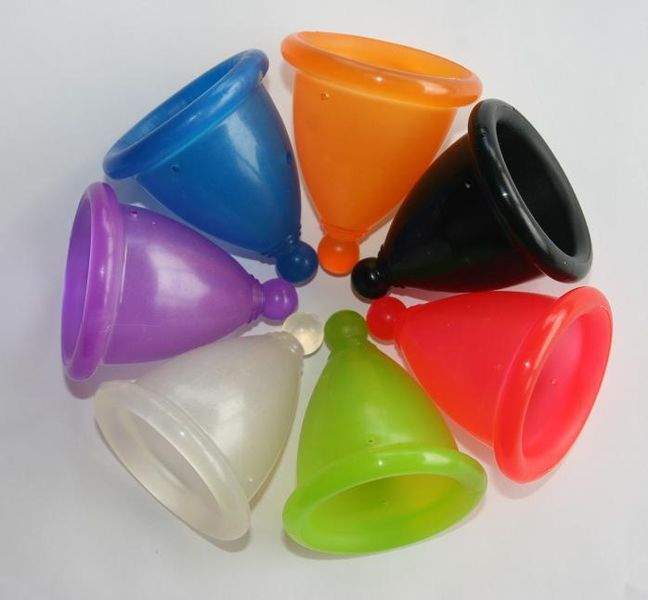
When I first heard about the menstrual cup, I was seeking to get rid of tampons, which happen to be bleached, mostly tested on animals, and carry a risk for toxic shock syndrome.
After I found out that tampons weren’t helping us girls out, I set out to find something else besides pads that could help me out at that time of the month. That was when I stumbled across the menstrual cup.
There’s a fabulous community of women online that will happily introduce anyone to the menstrual cup. Some girls are ready to make the switch—others need some convincing. I was ready to switch, and ordered my first menstrual cup after reading about it online.
The menstrual cup is a small cup that usually comes in two sizes—small and large—made out of medical-grade silicone or natural rubber latex that is inserted into the vagina, catches the menstrual flow, and then is removed and emptied when full, or, after up to 12 hours.
The biggest thing to keep in mind about the menstrual cup is cleanliness, as not washing our hands or the cup when taking it out or inserting it can increase our risk for urinary tract infections (which, sadly, happened to me my first summer with the menstrual cup). When taking it out or putting it back in, we have to be diligent about washing our hands first and washing the cup. I use natural castile soap to do both.
The menstrual cup is not tested on animals and there’s no known risk of toxic shock syndrome. When used properly, the menstrual cup can help alleviate menstrual cramps and make our periods lighter. But perhaps the most important thing the menstrual cup offers to women and girls is the opportunity to get familiar with their bodies, something we seem to be rather ignorant of in this day and age.
Tampons come in wrappers, in pretty colors, they can be plastic or cardboard, but in the end, they’re all disposable and are meant to be discarded immediately after they’ve absorbed the correct amount of blood from us.
Month after month, year after year during our menstrual cycle, here we are being ignorant of our bodies and producing tons of waste that will eventually end up in landfills. Not to mention increasing our risk for health problems like toxic shock syndrome!
The menstrual cup seeks to change that.
The menstrual cup has a lifespan of ten years or more—in fact, it may never need to be replaced. The menstrual cup is much more than just sticking a cup up your vagina: it requires us to get familiar with our anatomy because the menstrual cup depends on proper placement in order to do its job properly.
Women bleed from their cervix, which is a small knob that feels very much like the end of our noses, and also marks the entrance to the womb. Without successfully locating this, the menstrual cup won’t work and will end up leaking (which, trust me, can be incredibly frustrating).
The position of each woman’s cervix will be unique to her. Some women have high cervixes, some have low, some are angled left, or right. We need to find our cervix and then determine which cup would suit us best based on the position. The size of the cup will also depend on your age and if you’ve given birth or not.
The menstrual cup has totally changed my period by forcing me to get more familiar with myself down there. My cervix is angled slightly to the right, so I need to position my cup so. After going through three menstrual cups to find my perfect fit and ditching tampons for good, my period has gotten light, my cramps have gotten better, and I feel so in touch with my body.
The menstrual cup asks us all to pay attention to our impact on the planet, our bodies, and to look at the risks we’re creating by using tampons and pads. Conventional tampons and pads are bleached, are tested on animals, and pose risks for our bodies. We’re also creating tons of waste every year, and unnecessarily. Why spend money, time, and create waste every month buying tampons when we could order just one (or two!) menstrual cups and spend the years of our fertility being eco-conscious and in-touch with our bodies and the world?
Menstrual cups may be a revolutionary idea for some, or it may be old news to some of us girls! After all, they’ve been around since the 1930s, but were not commercial until about the 70s. Regardless of where we stand on the menstrual cup, we can all make better, healthier choices for ourselves, our bodies, and the planet by exploring the option of menstrual cups. For when the menstrual cup doesn’t quite do it for us, reusable, washable cloth pads can do the job as well.
The menstrual cup asks us to take another look at how we spend that week every month—cramped over in pain with bleached rayon shoved up our vaginas, or comfortable and secure with a reusable menstrual cup?
Oh, and did I mention the menstrual cup works for up to twelve hours, does not leak at all when inserted properly, and is not able to be felt at all once inside? What more could a girl want for period protection?
Let’s consider the impact of conventional pads and tampons on our bodies and on the planet—and let’s consider a menstrual cup to catch our flows next month!
Relephant:
Are Your Tampons Toxic?
Author: Jenn Ryan
Editor: Catherine Monkman
Photo: Wikimedia Commons







Read 38 comments and reply